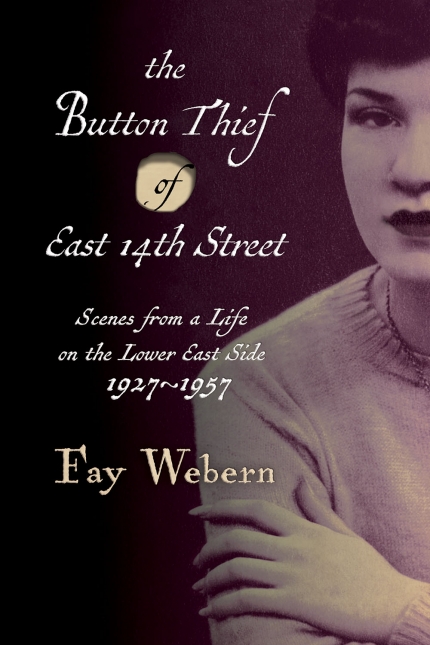The Button Thief of East 14th Street: Scenes from a Life on the Lower East Side 1927-1957
- By Fay Webern
- Sagging Meniscus Press
- 330 pp.
- Reviewed by Y.S. Fing
- January 27, 2017
A powerful memoir of growing up in Depression-era Manhattan.

They fuck you up, your mum and dad.
They may not mean to, but they do.
They fill you with the faults they had
And add some extra, just for you.
— “This Be the Verse” by Philip Larkin
Larkin speaks an eternal and painful truth. By conditioning you as they themselves were conditioned, parents inherently do two things: Make you what you build yourself out of, and make it very hard for you to build yourself at all. As everyone who takes the necessary steps in maturation, intellectual and emotional, comes to realize, “They may not mean to, but they do.”
How we respond to this complicated formula of filial self-awareness, frustration, rejection, acceptance, and resignation is the central issue of many memoirs. Because each microcosmic example of the development of life can be so fascinating, so replete with repressions, confusion, and consequence, we want to hear how people have come to survive their own fraught youths.
In The Button Thief of East 14th Street, we are introduced to FeygaPinya Kessler (the birth name of the memoir’s author, Fay Webern), who comes into being coincidental to her family’s moving into the Lavanburg homes, a philanthropical undertaking to improve the lives of residents of the Lower East Side of New York in the early 20th century. They were poor during the Depression, but Fay’s mother was determined to live a clean life in hard circumstances.
Both Fay’s parents’ families had emigrated from Russia, fleeing pogroms and revolution. Fay’s father remains a distant figure through most of the book, regularly avoiding home because of social and employment-related obligations (but not always for altruistic reasons). Fay’s mother makes ends meet by selling peanuts in Battery Park and by plucking chickens under the Williamsburg Bridge. Fay has an elder sister she adores and rooms with, and two brothers, one at least 10 years older, and the other a bully of sad proportions.
Fay is essentially on her own throughout childhood, led to believe at every turn that it’s a man’s world, and that she must submit to forces she can’t even see, let alone understand. Her mother keeps her apart from her father’s family. Her mother is Jewish but also superstitious, so Fay learns to spit three times when good fortune arrives in order to ward off the evil eye of envy.
Fay’s perspective of New York in these days (the title implies a 30-year span, but most of the events of the book occur before 1945) is extremely limited; the book contains a lovely map of the Lower East Side neighborhood within which a child could live for years without ever learning of anything beyond it. Fay’s evocations of life in the Lavanburg homes are as powerful and thorough as anyone would want, but she’s not florid and ornate. These are spare black-and-white photos, a vision akin to Walker Evans.
With large families and dense living conditions, many of the occurrences of Fay’s youth were public events, like when Frank Wing, the local laundry guy, chased his live-in girlfriend down the street because she’d stolen his cash. Or when the mothers of the neighborhood teamed up to shame Fay’s father into not abandoning his family. The eponymous button-thieving episode is the most public of them all, a catalytic humiliation so profound that Fay would never be the same unthinking, immature person again.
The most significant, productive discipline that Fay discovered was dance. A WPA program brought a modern-dance teacher into the basement of the Lavanburg homes once a week for seven years. Fay had wanted to learn how to Lindy Hop, but she learned physical expression instead, and it seems to have tapped into the living, breathing spirit that has helped her live the rest of her life.
Fay’s career was ultimately spent in publishing; she was copy chief at Scientific American and a senior editor at Encyclopedia Britannica, Harper & Row, and Random House. But that independence had to be built out of circumstances that caused both her and her sister to rush into marriages each was ill-suited for, and to raise children as single parents, just as their mother had.
Fay’s story is American. A child is born into certain circumstances, the boundaries of her life only as wide as her parents. But America’s promise is that the child can expand those boundaries with determination and perseverance. In these pages, Fay has crafted a reflection her mother could never have imagined. But, contrary to Larkin’s recommendation in “This Be the Verse,” Fay forgives her mother (and even her father, eventually). She doesn’t give in to Larkin’s misanthropy:
Man hands on misery to man.
It deepens like a coastal shelf.
Get out as early as you can,
And don't have any kids yourself.
In this lovely memoir, we’re reminded anew of the bittersweet nature of growing up. Fay Webern has rendered a way to break out of a cycle of misery and embrace the ambivalent joys of life.
Y.S. Fing is a composition lecturer at a local university and a literary gadfly in the DC area. He belongs to the Washington Biographer’s Group and is a committee member of the Washington Writers Conference. Recently, he has been experimenting with short essay form in Fingism and Finglish.

